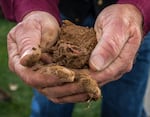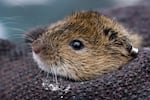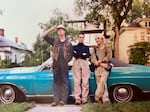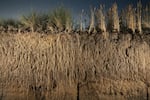Pals
Posted by Information Society on Monday, November 28, 2022
A camera crew, fresh from Los Angeles, runs through a cornfield north of Corvallis.
It’s 2004, and they are looking for a rock star. He played bass for Information Society, a band that soared to the top of the charts with its 1989 smash hit “What’s on your mind? (Pure Energy).”
The crew of VH1′s hit show “Bands Reunited,” steps through fields of tomatoes and basil, asking “Have you seen James Cassidy?”
They want to know if he’ll get back together with the rest of the band for a reunion show.
But Cassidy is now a soil scientist at Oregon State University, and his priorities have changed.
James tells the TV crew, “Maybe, but can you help harvest our basil first?”
Rock stardom to soil science seems like a circuitous path, but Cassidy says the magic is all about the soil.
“Every molecule in your body has been through the soil billions of times, and the fact that you’re not soil at this moment is a temporary condition,” he says. “It’s all about the soil.”
“— James Cassidy, soil scientist at Oregon State UniversityWhen we lose agriculture, we don’t have anything to eat. All culture comes from agriculture. All civilizations come from agriculture. We will eventually return to the soil.”
But the Earth is losing topsoil at an alarming rate, he says. About 2 hectares of soil are lost every eight seconds. According to the United Nations, if soil erosion continues at its current pace, the world’s remaining topsoil will be gone in 60 years. Soil erosion, nutrient depletion and salinization aren’t just theoretical concerns, they are existential threats.
“When we lose agriculture, we don’t have anything to eat,” Cassidy says. “All culture comes from agriculture. All civilizations come from agriculture. We will eventually return to the soil.”
We’ve heard this story before. Many scientists believe that ancient civilizations such as Mesopotamia, the Indus River Valley and Neolithic Europe all crumbled due to poor soil practices. In the Midwest of the U.S., roughly 200 million acres of cropland were permanently damaged by overly intensive tillage — an event notoriously named “The Dust Bowl.” Immense “black blizzards” carried the Great Plains topsoil as far east as New York City. Roughly 2.5 million people left the Dust Bowl states. This mass emigration was one of the largest migrations in American history.

A handful of soil is a mixture of sand, silt, clay and organic matter — but it’s more than that. From billions of microbes to voles, it’s a collection of creatures both living and dead — many of which have never seen the light.
Courtesy of Lance Cheung/USDA
Going underground
Dirt, grit, smudge and schmutz; soil has too many names to count. Our planet shares its name with the same substrate that grows your garden and sneaks under your fingernails. Soil is everywhere. Soil is grounded, it’s firm, we walk on it.
But Cassidy says the value of soil lies not just in what is firm, but the holes within.
“Oh, there’s a poop!” Cassidy says.
He’s using a 3-foot-long tube camera that twists and snakes, revealing the vole’s mysterious world in this OPB video that aired in 2007.
Cassidy noticed that plants thrive near vole holes. The soil near the rodents’ homes held water the longest and nearby plants stayed green longer. He knew there must be a connection and wanted to find out why.
“This is an active tunnel,” Cassidy says.
His camera probes deeper.
“Oh my god, that’s beautiful.”
His camera is face-to-face with a vole frozen in its lair. Cassidy is ecstatic. The vole seems terrified by this robotic invader.

James Cassidy uses a long tube camera to peer into a vole hole in his 2007 research. The vole digs to solve a problem. In a world filled with many animals that like to eat voles, they find safety underground. They dig subterranean labyrinths filled with twists, turns and dead-ends.
Michael Bendixen / OPB
Cassidy says soil is filled with holes — small, medium, large, and everything in between.
Things that live need air and water. Holes create this living space. Large holes, like the ones voles create, allow soil to drain faster. These large voids hold the oxygen that living things need. Small holes retain and even draw up water, through capillary action.
Medium holes strike the balance of not locking in water or draining it away. These medium Goldilocks holes allow water to hang out and be available, easy for the plants to drink.
Plants thrive in soils with Goldilocks holes. They don’t just seek them out — they create them. They follow the paths of their ancestral roots, long rotted away. As the root gets bigger, they push particles around, eventually creating a diverse set of holes. Plants engineer soil, in a way, shaping it to be more favorable to their needs. But plants aren’t the only soil engineers.

The gray-tailed vole is the most common vole in Oregon’s Willamette Valley.
Courtesy of Peter K. Ziminski/Shutterstock.com
Cassidy recalls a research plot where he caught a vole. He brought it to his lab, and the next night it rained. The vole’s holes were flooded.
He released the vole near a hole that wasn’t flooded. The vole ran back to its original flooded tunnel and dove directly into the water.
“I was amazed,” Cassidy says. He hypothesizes that the vole knew it would find safety in a hidden chamber that had a pocket of air.
Learning from vole holes
Cassidy is intrigued by these air pockets. He figures water drainage is one benefit of voles, but plants also need air spaces, voids that hold available water and nutrients.
In an experiment, Cassidy poured plaster down several of their holes. In some tunnels, he was able to fill the holes with 20-30 gallons of liquid plaster — the vole’s underground network was that vast.
Cassidy and his team slowly dug out dirt, revealing an intricate web of plaster. The vole’s clandestine home was revealed.
Cassidy noticed that there were blobs of plaster, like cisterns, perfect for storing water.

Cassidy uses a trowel to remove soil from the plaster he poured down a vole hole to reveal the vole’s intricate tunnel system.
Michael Bendixen / OPB
Plants thrive in soils that have water always available, but not too much at once. These water-holding chambers could help explain why the soil stayed moist longer when voles were present.
Cassidy noticed something else: These drainage systems seemed to get more efficient over time.
The plaster revealed a series of smaller holes that clustered around the main tunnels. But they were too small for voles; instead, they were the perfect size for worms. The plaster revealed that more vole holes equal more worm tunnels.
Cassidy found as voles expanded their network, worms followed in concert, making even more holes in the soil. Thus, the soil was exponentially improved for plants.
“It’s as if somehow the voles and the worms communicated, and maybe not in a communication that we understand,” he says.

Deep inside a vole hole, Cassidy discovered grass clippings and vole feces. Voles bring grass deep down into their nest, moving fresh organic matter through the system.
James Cassidy / OPB
Holes in soil do more than just drain or hold water; they also help move organics and nutrients through the soil. By exploring vole holes with the tube camera, Cassidy noticed that the tunnels deep underground are lined with green grass.
The voles are lining their homes with soft bedding, and by doing so, they are moving organics deep into the soil system. This has an outsized effect.
“You want to know what the answer is to anything? It’s add organic matter,” Cassidy says.
Organic matter — things that used to be living — is made of carbon harvested from the air and energy captured from the sun, Cassidy says. Then, the carbon and energy feed microbes. The microbes decompose the organic matter, making nutrients and energy available to plants. And organics decompose at different rates, creating a bank of slow-released nutrients, benefiting the soil over time.
Organic matter creates a feedback loop of soil success. The more organic matter in the system, the more it creates an environment for the soil to have even more. It’s exponential. Like holes in soil, organic matter can help retain water.
“When you increase organics by 1%, you can store 25,000 gallons more water per acre in that soil,” Cassidy says.
Voles have clear benefits to the soil, but Cassidy is quick to point out that there can be too much of a good thing.
“— James Cassidy, soil scientist at Oregon State UniversityNo matter who I meet or what their worldview is, no matter how divided we are, it’s really our common ground. We all need soil to survive.”
Vole populations go through boom-and-bust cycles. In the boom years, voles can completely take over a farmer’s field.
“They are voracious eaters. They’ll consume anything in their path,” says Tim Kreder, a grass seed farmer who witnessed one such vole explosion on his land. “The voles were terrible. They were horrific. I had never seen anything like it in my 30 years of farming.”
Voles will boom, bust and boom again. But their holes remain.
Soil is not a noun, but a verb, Cassidy says. It’s not a thing, but an active process.
“You can think of soil as a living host,” he says. “It’s more than bits of clay and silt, it’s a community.”
Soil isn’t static. You can see Cassidy regularly helping his students at the OSU Organic Growers Club, wearing his signature fedora and black T-shirt with “SOIL” in bold white letters.
From rock-and-roll misfit to soil expert
But it wasn’t always this way.
“I was a stoner, rock and roller, D-minus student in high school,” Cassidy says. “I was pretty flamboyant.”
Growing up in suburban Minnesota, Cassidy remembers getting beat up for being different. He says he and others who felt this way found that “playing music was a way to bring people together that didn’t fit in so they could express themselves.”

Information Society’s founding band members Paul Robb, left, Kurt Larson, center, and James Cassidy, right, pose in front of a car in Minneapolis, Minnesota in 1986. They were high school friends. Speaking of the early years of the band, Cassidy says it was “the weirder the better. We’d wrap ourselves in plastic bags, sang through vacuum hoses. We pushed the audience pretty far.”
Courtesy of Kristie Leader
His high school counselor said he wasn’t college material, but he remembered the northern Minnesota summers, the 20,000 lakes left from glaciers, the summer fragrance of the deep woods. He stumbled upon a fisheries management program at Mount Hood Community College.
“I liked it, and I was a straight-A student for the first time in my life,” he says.
Eventually, Cassidy earned his master’s at Oregon State University in crop and soil science with an emphasis on soil.
Beyond his soil classes, he founded the OSU Organic Growers Club, where students sell the produce they grow and use the money to support scholarships.
Cassidy makes YouTube videos where he uses some of his past rock star artistry to draw in his students.
“The first time I taught, I wore a suit, there was lights, a stage, and I was like … I know this,” he says.

Wearing his ever-present “SOIL” shirt, Cassidy takes the stage in Mexico City on Feb. 12, 2023. Founded in 1982, Information Society (also known as InSoc) still makes records and tours.
Courtesy of Oscar Panduro
A call to help rebuild soil
His unique biography inspires his teaching.
When Cassidy wears his black T-shirt with “SOIL” emblazoned in white letters, he’s sending a message.
“No matter who I meet or what their worldview is, no matter how divided we are, it’s really our common ground,” he says. “We all need soil to survive.”
In one of his soil classes, he tells his students: “Soil is one of the most underappreciated things on earth, but it’s everywhere.”
In every handful of soil, there are more life-forms than the number of people who have ever lived on planet earth.
“— James Cassidy, soil scientist at Oregon State UniversityThey will have to figure it out and they will. They have to. It’s their life, and that gives me hope.”
“I think my main message is spreading awareness,” Cassidy says. He warns his students that soil fertility that took millennia to produce could be destroyed in a few years.
“The way we manage land, the way we do agriculture, all that stuff is absolutely critical going forward if we’re gonna make it,” Cassidy says.
Moving from agriculture that extracts to farming that regenerates the land, is one solution that Cassidy encourages. Regenerative agriculture is a holistic approach to farming that emphasizes the ecological system as a whole. Soil is more than just sand, silt and clay, but an interconnected world of roots, worms and voles.
Cassidy says, “We need to focus more on soil-building rather than soil-using.”
With a focus on limited tillage, adding organic matter and including more perennial crops, regenerative agriculture sees feeding the soil like investing in a bank: you can obtain benefits over a long period of time with careful stewardship.

The roots of Kernza® perennial grain, left, and annual wheat, right, are compared, at The Land Institute research plots, in Salina, Kansas. No one is alive today to remember what the tall grass prairie looked like. For millennia, grass grew, lived and died, creating complex root systems, full of voids, and their roots and organic matter helped create some of the most productive soil on earth. Planting perennial crops is one important element of regenerative farming.
Courtesy of Jim Richardson
The World Bank warns that by 2050 there could be more than 140 million climate refugees from desertification, rising sea levels, drought and a range of other factors. Desertification ultimately means that people can’t grow food on the land anymore.
When faced with the calamity of our soil degradation, Cassidy says it’s easy to be discouraged, but his students give him hope.
“When we are out at the student farm, at the end of a long work day, I’m exhausted,” he says. “They’re exhausted. But a student says, ‘We should get that basil.’ My inner voice says we could just do it tomorrow. But they are like, ‘Let’s do it now!’”
Solutions are not easy. But Cassidy keeps going on his stage, in the classroom and on YouTube, sharing the story of soil, voles and holes with his students.
“They will have to figure it out and they will,” he says. “They have to. It’s their life, and that gives me hope.”
